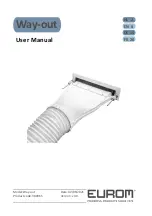
33
English
NOTE
• If the power of some units is turned off, the charging procedure can-
not be finished properly.
• In case of a multiple outdoor system, turn on the power of all out-
door units.
• Make sure to turn ON the power 6 hours before starting the opera-
tion. This is necessary to warm the crankcase by the electric heater.
• If operation is performed within 12 minutes after the indoor and
outdoor units are turned on, the compressor will not operate before
the communication is established in a correct way between outdoor
unit(s) and indoor units.
• Before starting charging procedures, check if the segment display
indication of the main printed circuit board (A1P) is as normal (see
13.2. Operating the push buttons and DIP switches on the printed
circuit board on page 28). If an error code is present, see 15.5. Error
code list on page 44.
• Make sure all connected indoor units are recognized (see
15.2. Monitoring function and field settings on page 36).
• Close the front panel before any refrigerant charge operation is
executed. Without the front panel attached the unit cannot judge
correctly whether it is operating properly or not.
NOTE
In case of maintenance and the system (outdoor unit+field
indoor units) does not contain any refrigerant any more (e.g.,
after refrigerant reclaim operation), the unit has to be charged with its
original amount of refrigerant (refer to the nameplate on the unit) by
pre-charging before the automatic charging function can be started.
14.3.2. Charging method
As explained during vacuum drying method, once vacuum drying is
finished, additional refrigerant charging can start.
There are two methods to charge additional refrigerant. Use the se-
lected method following the described procedure below.
• Adding refrigerant by using the automatic refrigerant charging
function. See A. Adding refrigerant by using the automatic charging
function on page 34. This method uses an automated method for
charging refrigerant.
• Adding refrigerant by using the manual refrigerant charging func-
tion. See B. Adding refrigerant by using the manual charging func-
tion on page 34. This method uses a manual method for charging
refrigerant.
A flow chart is available which gives an overview of the possibilities
and actions to be taken (see 14.3.1. Flow chart on page 31).
To speed up the process of pre-charging refrigerant for large systems,
it is recommended to first charge a portion of the refrigerant before
performing automatic or manual charging. This step is included in
below procedure. This step can be skipped, charging will take longer
in such a case.
Follow the steps as described below and take into account whether
you want to use the automatic charge function or not.
1
Calculate the additional amount of refrigerant to be added using
the formula mentioned in 14.2. Calculating the additional refriger-
ant charge on page 30.
2
The first 22 lbs. (10 kg) of additional refrigerant can be charged
without outdoor unit operation.
If the additional refrigerant amount is smaller than 22 lbs. (10 kg),
perform the pre-charging procedure as explained in step 3 and 4a
below.
If the additional refrigerant charge is larger than 22 lbs. (10 kg),
perform step 3 till the end of the procedure.
3
Pre-charging can be done without compressor running by connect-
ing the refrigerant bottle only to the liquid stop valve service port
(open valve A). Make sure that all outdoor unit stop valves, as well
as valves B and C are closed.
1
2
3
4
5
6
A
B
C
8
7
9
9
10
12
11
13
14
15
1 Gauge manifold
2 Nitrogen
3 Measuring instrument
4 Refrigerant R410A tank (siphon system)
5 Vacuum pump
6 Charge hose
7 Gas line stop valve
8 Liquid line stop valve
9 Outdoor unit
10 To indoor unit
11 Stop valve
12 Field piping
13
Gas flow
14 Stop valve service port
15 Refrigerant charge port
A Valve A
B Valve B
C Valve C
4
a) If the calculated additional refrigerant amount is reached by
above pre-charging procedure, close valve A.
b) If the total amount of refrigerant could not be charged by
precharging, then close valve A and go to step 5. Follow step 6
depending on the chosen charging method.
INFORMATION
If the total additional refrigerant amount was reached in step 4 (by
pre-charging only), record the amount of refrigerant that was added
on the additional refrigerant charge label provided with the unit and
attach it on the back side of the front panel. Perform the test procedure
as described in 15.4. Test operation on page 43.
5
After pre-charging, perform the refrigerant charge operation as
shown below and charge the remaining refrigerant of the additional
charging amount through valve B.
Open the liquid and gas side stop valves. Valves A, B and C must
remain closed!
INFORMATION
For a multi outdoor unit system, it is not required to connect all charge
ports to a refrigerant tank.
The refrigerant will be charged with 22 kg in 1 hour time at an outdoor
temperature of 30°C DB or with 6 kg at an outdoor temperature of 0°C
DB.
If you need to speed up in case of a multiple outdoor system, connect
the refrigerant tanks to each outdoor unit.
01_EN_Main_VRV6_HP_IM.indd 33
01_EN_Main_VRV6_HP_IM.indd 33
2022/12/08 17:56:16
2022/12/08 17:56:16
















































